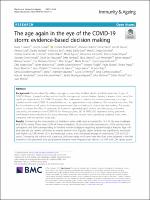| dc.contributor | Vall d'Hebron Barcelona Hospital Campus |
| dc.contributor.author | Martín, María C. |
| dc.contributor.author | Jurado, Aurora |
| dc.contributor.author | Abad Molina, Cristina |
| dc.contributor.author | Orduña, Antonio |
| dc.contributor.author | Yarce, Oscar |
| dc.contributor.author | Navas, Ana M. |
| dc.contributor.author | Hernández González, Manuel |
| dc.contributor.author | Perurena Prieto, Janire |
| dc.date.accessioned | 2022-01-13T17:53:51Z |
| dc.date.available | 2022-01-13T17:53:51Z |
| dc.date.issued | 2021-05-20 |
| dc.identifier.citation | Martín MC, Jurado A, Abad-Molina C, Orduña A, Yarce O, Navas AM, et al. The age again in the eye of the COVID-19 storm: evidence-based decision making. Immun Ageing. 2021 May 20;18:24. |
| dc.identifier.issn | 1742-4933 |
| dc.identifier.uri | https://hdl.handle.net/11351/6797 |
| dc.description | Coronavirus SARS-CoV-2; COVID-19; 2019-nCoV; Immunosenescència; Confinament |
| dc.description.sponsorship | This work has been carried out without funding. |
| dc.language.iso | eng |
| dc.publisher | BMC |
| dc.relation.ispartofseries | Immunity & Ageing;18 |
| dc.rights | Attribution 4.0 International |
| dc.rights.uri | http://creativecommons.org/licenses/by/4.0/ |
| dc.source | Scientia |
| dc.subject | COVID-19 (Malaltia) - Epidemiologia |
| dc.subject | Medicina clínica - Presa de decisions |
| dc.subject | COVID-19 (Malaltia) - Factors de risc |
| dc.subject.mesh | Coronavirus Infections |
| dc.subject.mesh | /epidemiology |
| dc.subject.mesh | Clinical Decision-Making |
| dc.subject.mesh | Severity of Illness Index |
| dc.title | The age again in the eye of the COVID-19 storm: evidence-based decision making |
| dc.type | info:eu-repo/semantics/article |
| dc.identifier.doi | 10.1186/s12979-021-00237-w |
| dc.subject.decs | infecciones por Coronavirus |
| dc.subject.decs | /epidemiología |
| dc.subject.decs | toma de decisiones clínicas |
| dc.subject.decs | índice de la gravedad de la enfermedad |
| dc.relation.publishversion | https://doi.org/10.1186/s12979-021-00237-w |
| dc.type.version | info:eu-repo/semantics/publishedVersion |
| dc.audience | Professionals |
| dc.contributor.organismes | Institut Català de la Salut |
| dc.contributor.authoraffiliation | [Martín MC] Centro de Hemoterapia y Hemodonación de Castilla y León, Valladolid, Spain. [Jurado A, Yarce O, Navas AM] Department of Immunology and Allergology, Hospital Universitario Reina Sofía-Instituto de Investigación Biomédica de Córdoba (IMIBIC), 14004 Córdoba, Spain. [Abad-Molina C, Orduña A] Department of Microbiology and Immunology, Hospital Clínico Universitario, Valladolid, Spain. [Hernández M, Perurena-Prieto J] Servei d’Immunologia, Vall d’Hebron Hospital Universitari, Barcelona, Spain |
| dc.identifier.pmid | 34016150 |
| dc.identifier.wos | 000652608400001 |
| dc.rights.accessrights | info:eu-repo/semantics/openAccess |

